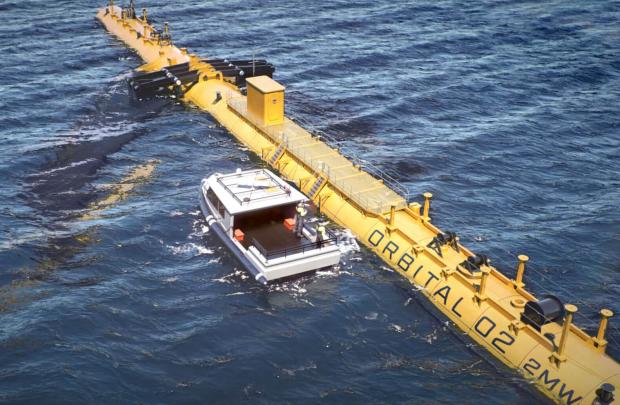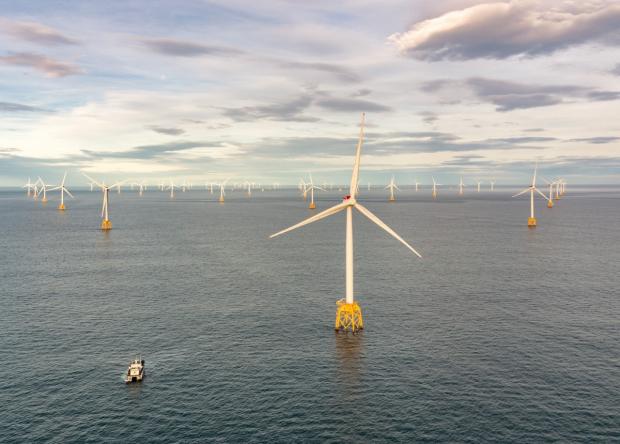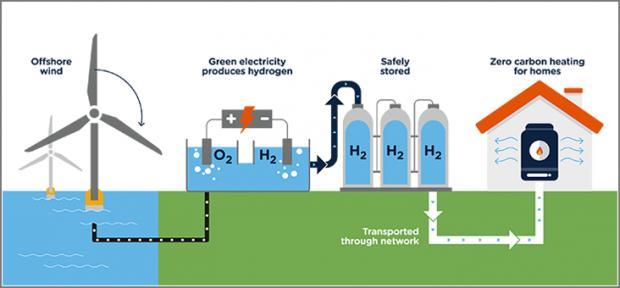
[ad_1]
THE CHAIRMAN of the Scottish National Investment Bank has warned that crucial private sector funding needed to get tidal power and green hydrogen industries up and running is being put off by a lack of proven technology – denting the SNP-Greens’ renewable energy vision.
Westminster politicians have been told to send a clear message that they have confidence in the innovation in order to bring in funding – amid a warning the technology could be scaled up first overseas, despite Scotland’s huge potential to grow the sectors.
The investment bank was set up by Nicola Sturgeon and tasked with leveraging in private sector cash, specifically for assisting Scotland’s pledge to end its contribution to climate change by 2045.
The Scottish Government is aiming to generate half of the nation’s energy from renewable sources by 2030 and already, the vast majority of electricity is generated from renewables.
But in the co-operation deal forged between the SNP and Greens, there is an agreement that “there is enormous potential to harness Scotland’s natural resources through emerging wave, tidal and floating offshore wind technologies”.
Simply put, tidal power is harnessing the energy produced by tides – a very predictable form of renewable energy usually generated by underwater turbines.
The largest tidal turbine in the world, the 02 turbine, currently anchored at the European Marine Energy Centre at Orkney, will generate 2MW of energy – enough to power 2,000 homes.
 The Orbital O2 turbine
The Orbital O2 turbine
The Scottish Government’s updated climate change plan published in December warns that tidal and wave energy “remain at an early stage of development”, warning that “the key levers required to commercialise the technology” are “reserved to the UK Government”.
Finance Secretary Kate Forbes issued a stark warning earlier this year that Scotland will not meet its strict climate targets without “leveraging in private investment”.
But Willie Watt, the chairman of the Scottish National Investment Bank, has warned MSPs that the strategy is in jeopardy after insisting “there are gaps” in emerging technologies.
READ MORE: Scotland set for £25bn economic boost through low-carbon hydrogen
He added: “For example, in green hydrogen, I think there is a shortage of capital for projects in that area because the uses of that technology maybe proven on a small scale, but they are not proven on a large scale. The same might be true with regard to tidal power.
“I hope that one of the things that we can do is prove that commercial investments can be made in these sectors which will then give confidence to the private sector to come in beside us.”
Energy policy is largely reserved to the UK Government, and Scottish Green Skills Minister Lorna Slater has warned a 2015 decision by Westminster politicians that “ended market support for offshore renewables such as tidal energy” has meant that “Scotland is six years behind where we could have been in building and installing tidal turbines”.
 Green Skills Minister Lorna Slater
Green Skills Minister Lorna Slater
She has stressed that advancement “has been held back by the UK Government’s lack of support.”
But earlier this month, the UK Government appeared to be finally showing support for tidal energy after opening bids for a £265 million subsidy pot in the next round of its Contract for Difference – where tidal projects will be able to bid for a share of a £55 million fund.
The Scottish Government had called on UK ministers to “reform the Contract for Difference mechanism to deliver specific support for wave and tidal generation”.
Neil Kermode, managing director of the European Marine Energy Centre, said the sector is “poised” to be ramped up.
Kermode told the Herald on Sunday that although there were “some positive signs” from the latest UK Government contract rules, he warned “there are some shortcomings” – such as a lack of ring-fenced funding for tidal projects.
He added that governments “had lost faith in marine” leading to efforts “to re-establish that trust”.
Kermode said that wind power has been scaled up effectively due to government support and is hopeful the same strategy can be adopted by tidal energy.
He said: “Effectively wind power had a number of years working its way through how you do this. It was working out the best way to do it – then people standardised and settled on the right thing to do.
 Offshore wind has scaled up after gaining government support
Offshore wind has scaled up after gaining government support
“They have just perfected it and built a lot of them. By building a lot of them, the price comes down.
It was also very, very, very strongly favoured by government that that’s what they wanted to see happen.”
He added: “What we do not want to do is go bust and hundreds of machines out there and we find there’s a technical fault with the process.
“Wind worked it way through systematically. We believe we could follow the same trajectory. We believe we are good to go but we are at an early stage.”
Scotland is believed to have around one quarter of Europe’s total tidal energy potential – with a strategy being drawn up to export the asset to the continent.
Kermode stressed “there are gigawatts of energy in the water around Scotland” and “we now know there’s technology that can extract it”.
READ MORE: SNP’s energy targets at risk by Scottish grid ‘premium’ charges
Pointing to Mr Watt’s comments about private sector apprehension, he said: “I understand why people are a bit nervous about it because it’s a bit different.
“A clear message of support from Government, and setting out a target, for example, would give that confidence to the market that this is worth going for. Private investment will come in to this, once they are sure there’s money to be made – that’s always the case.
“If we let this potential go, we will not get it back – we will end up having to buy it back.”
Ben Miller, senior policy manager at Scottish Renewables said tidal power and green hydrogen “are examples of renewable technology with immense potential to be deployed at commercial scale” along with “all the economic and environment benefits that would bring”.
READ MORE: Tidal energy pioneer hails results of turbine tests as it eyes global market
He added: “Scotland has a quarter of Europe’s tidal resource and has deployed world leading technology, and green hydrogen will be essential in helping industry and heavy transport to decarbonise.
“As with offshore wind ten years ago, both these innovative technologies need strategic financial support at a pre-commercial scale, and it’s heartening to see the bank recognise this in recent announcements. We also need to see the UK CfD (Contract for Difference) mechanism work better for less established technologies like tidal power, by ringfencing support and prioritising deployment over competition.”
But the Scottish Conservatives have claimed that the warnings over private sector confidence in the technology is another example of the SNP Government failing to take businesses with them in supporting key policies.
The party’s net zero, energy and transport spokesperson, Liam Kerr said: “We’ve warned for years that the SNP has to bring people and businesses along with them in the fight against climate change.
 Scottish Conservative MSP Liam Kerr
Scottish Conservative MSP Liam Kerr
“Instead, emboldened by their new Green colleagues, they have come up with unpopular and unworkable policies that has alienated business and investors when we need them most.
“It is yet another example of how the nationalists are not doing enough to protect our environment.”
As well as scaling up tidal power over the next few years, the Scottish Government has set an aim to generate 5GW of renewable and low-carbon hydrogen by 2030 and more than 25GW by 2045.
Low-carbon or blue hydrogen is produced from reforming natural gas and preventing CO2 entering the atmosphere by carbon capture and storage technology. Green hydrogen is made through a process called electrolysis where water is split into hydrogen and oxygen – but it currently a more expensive option.
 Green hydrogen is produced through electrolysis (Picture: SGN)
Green hydrogen is produced through electrolysis (Picture: SGN)
SNP Net Zero Secretary Michael Matheson has stressed that “one of the most effective ways of decarbonising domestic heating” would be by using hydrogen in the natural gas network and has called on the UK Government to “give consent to decarbonising the natural gas system”.
A Scottish Government spokesperson said: “With our abundant natural resources, expertise and forward-looking policy approach, Scotland is ideally-placed to harness the enormous global market for marine energy whilst helping deliver our net-zero economy. This is why the Scottish Government has long-supported marine energy and invested more than £40 million to date in the internationally-renowned Wave Energy Scotland programme.
READ MORE: How Scotland can kickstart the economy through green energy
“Scotland has potential to produce significant quantities of green hydrogen from our offshore and onshore wind resources and our potential wave and tidal power. In addition to this, proximity to large scale offshore renewables, may allow our islands and rural locations to play a key role in the production and export of hydrogen to the rest of Scotland, UK and Europe.
“We recognise that the development of a domestic hydrogen sector will play an important role in supporting a just transition to net zero by 2045, and presents significant long-term economic opportunities.
“However, many of the levers required to support the emergence of a flourishing hydrogen economy in Scotland are reserved to the UK Government. While the publication of the UK hydrogen strategy is welcome, it is critical that they continue to work with us to ensure that our collective vision for the development of the hydrogen economy is aligned, and the benefits of this developing sector are realised across the UK.”
Earlier this year, MPs on Westminster’s Environmental Audit Committee, wrote to the UK Government Business, Energy and Industrial Strategy Secretary, Kwasi Kwarteng, insisting that “there is substantial potential for the tidal sector to make a significant and distinct contribution to the UK’s future mix of energy generated from renewable sources”.
 Kwasi Kwarteng
Kwasi Kwarteng
The letter added that the committee found it “disappointing” that the UK Government’s energy white paper, published in December, “would only commit to ‘considering’ the role of tidal energy”.
It added: “ In our view this single reference in a substantial policy document significantly undersells the UK’s potential in this field and sends the weakest of policy signals to potential investors.”
In response, Kwarteng said: “Whilst marine technologies are still at a relatively early stage of development, the present Government takes the view that they could have a role play in the UK’s long-term decarbonisation, ensuring that we meet our 2050 net zero emissions target.
“Government recognises the need for a diverse energy generating mix, complementing offshore wind with other renewable generation sources.”
[ad_2]
Source link